by Calculated Risk on 3/08/2019 03:35:00 PM
Friday, March 08, 2019
AAR: February Rail Carloads down 2.7% YoY, Intermodal Down 0.9% YoY
From the Association of American Railroads (AAR) Rail Time Indicators. Graphs and excerpts reprinted with permission.
On the surface, rail traffic in February 2019 wasn’t very good. Total carloads were down 2.7% over February 2018, just the second monthly decline in the past year; 12 of the 20 carload categories were down, the most since January 2018; and intermodal was down 0.9%, its first decline in two years. But, like last month, weather likely played a significant but impossible-to-measure-precisely role in February — e.g., higher than normal rain and snow in California, with mudslides and track washouts thrown in for good measure; high winds, extreme cold, and record snowfalls in the Upper Great Plains; and so on. Winter always brings problems for railroads, but it seems this year was worse than last year in many areas.
emphasis added
 Click on graph for larger image.
Click on graph for larger image.This graph from the Rail Time Indicators report shows U.S. average weekly rail carloads (NSA). Red is 2019.
Rail carloads have been weak over the last decade due to the decline in coal shipments.
U.S. railroads originated 999,978 total carloads in February 2019, down 2.7%, or 28,238 carloads, from February 2018. Total carloads averaged 249,995 per week in February 2019. Since 1988, when our data begin, the only February with a lower weekly average was 2016. Total carloads were down in three of the four weeks in February.
 The second graph is for intermodal traffic (using intermodal or shipping containers):
The second graph is for intermodal traffic (using intermodal or shipping containers):U.S. railroads also originated 1.09 million intermodal containers and trailers in February 2019, down 0.9%, or 9,513 units, from February 2018. (Intermodal is not included in carloads.) It was the first yearover- year monthly decline for intermodal since January 2017. Like carloads, intermodal was surely affected by the weather, but non-weather factors might have played a role as well — e.g., imports that came ashore earlier to beat potential higher tariffs. Also, it’s not like intermodal fell off a cliff in February 2019: weekly average intermodal volume was 273,625 units, the second most ever for February (behind February 2018).Traffic will pick up in March, and there might be some bounce back from the poor weather.
Comments on January Housing Starts
by Calculated Risk on 3/08/2019 01:19:00 PM
Earlier: Housing Starts Increased to 1.230 Million Annual Rate in January
Total housing starts in January were well above expectations, however starts for November and December were revised down.
The housing starts report released this morning showed starts were up 18.6% in January compared to December, and starts were down 7.8% year-over-year compared to January 2018.
Single family starts were up 4.5% year-over-year, however multi-family starts were down 33.6%.
This first graph shows the month to month comparison for total starts between 2018 (blue) and 2019 (red).

Starts were down 7.8% in January compared to January 2018.
The weakness in January was in the multi-family sector that is volatile month-to-month.
All things considered, this is a decent start to 2019.
Below is an update to the graph comparing multi-family starts and completions. Since it usually takes over a year on average to complete a multi-family project, there is a lag between multi-family starts and completions. Completions are important because that is new supply added to the market, and starts are important because that is future new supply (units under construction is also important for employment).
These graphs use a 12 month rolling total for NSA starts and completions.

The rolling 12 month total for starts (blue line) increased steadily for several years following the great recession - but turned down, and has moved sideways recently. Completions (red line) had lagged behind - however completions and starts are at about the same level now (more deliveries).
As I've been noting for a few years, the significant growth in multi-family starts is behind us - multi-family starts peaked in June 2015 (at 510 thousand SAAR).
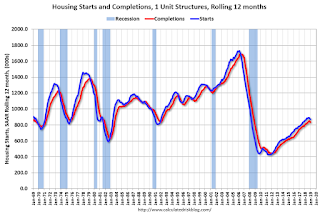
Note the relatively low level of single family starts and completions. The "wide bottom" was what I was forecasting following the recession, and now I expect some further increases in single family starts and completions.
Comments on February Employment Report
by Calculated Risk on 3/08/2019 09:22:00 AM
The headline jobs number at 20 thousand for February was well below consensus expectations of 178 thousand, however the previous two months were revised up 12 thousand, combined. The unemployment rate decreased to 3.8%, due to government employees on furlough being counted as employed in the February household survey. Overall this was a weak report, but it followed a strong January report, so there was probably some payback (the weather was good in January, and bad in February).
Earlier: February Employment Report: 20,000 Jobs Added, 3.8% Unemployment Rate
In February, the year-over-year employment change was 2.509 million jobs. That is solid year-over-year growth.
Average Hourly Earnings
Wage growth was at expectations in January. From the BLS:
"In February, average hourly earnings for all employees on private nonfarm payrolls rose by 11 cents to $27.66, following a 2-cent gain in January. Over the year, average hourly earnings have increased by 3.4 percent."
 This graph is based on “Average Hourly Earnings” from the Current Employment Statistics (CES) (aka "Establishment") monthly employment report. Note: There are also two quarterly sources for earnings data: 1) “Hourly Compensation,” from the BLS’s Productivity and Costs; and 2) the Employment Cost Index which includes wage/salary and benefit compensation.
This graph is based on “Average Hourly Earnings” from the Current Employment Statistics (CES) (aka "Establishment") monthly employment report. Note: There are also two quarterly sources for earnings data: 1) “Hourly Compensation,” from the BLS’s Productivity and Costs; and 2) the Employment Cost Index which includes wage/salary and benefit compensation.The graph shows the nominal year-over-year change in "Average Hourly Earnings" for all private employees. Nominal wage growth was at 3.4% YoY in January.
Wage growth has generally been trending up.
Prime (25 to 54 Years Old) Participation
 Since the overall participation rate has declined due to cyclical (recession) and demographic (aging population, younger people staying in school) reasons, here is the employment-population ratio for the key working age group: 25 to 54 years old.
Since the overall participation rate has declined due to cyclical (recession) and demographic (aging population, younger people staying in school) reasons, here is the employment-population ratio for the key working age group: 25 to 54 years old.In the earlier period the participation rate for this group was trending up as women joined the labor force. Since the early '90s, the participation rate moved more sideways, with a downward drift starting around '00 - and with ups and downs related to the business cycle.
The 25 to 54 participation rate decreased in February to 82.5%, and the 25 to 54 employment population ratio was unchanged at 79.9%.
Part Time for Economic Reasons
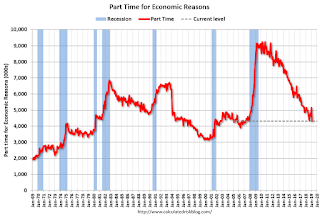 From the BLS report:
From the BLS report:"The number of persons employed part time for economic reasons (sometimes referred to as involuntary part-time workers) decreased by 837,000 to 4.3 million in February. This decline follows a sharp increase in January that may have resulted from the partial federal government shutdown."The number of persons working part time for economic reasons has been generally trending down. The number increased sharply in January, probably as a result of the government shutdown, and decreased sharply in February - to the lowest level since 2007.
These workers are included in the alternate measure of labor underutilization (U-6) that decreased sharply to 7.3% in February.
Unemployed over 26 Weeks
 This graph shows the number of workers unemployed for 27 weeks or more.
This graph shows the number of workers unemployed for 27 weeks or more. According to the BLS, there are 1.271 million workers who have been unemployed for more than 26 weeks and still want a job. This was up slightly from 1.252 million in January.
Summary:
The headline jobs number was well below expectations, however the previous two months were revised up slightly. The headline unemployment rate decreased to 3.8% due to unwinding from the government shutdown.
This was a weak jobs report - but it is probably mostly payback from the strong January report (and could be weather related). Some positives include the decline in the employment rate (expected following end of government shutdown), increase in wages, and decline in people working part time for economic reasons.
Housing Starts Increased to 1.230 Million Annual Rate in January
by Calculated Risk on 3/08/2019 08:52:00 AM
From the Census Bureau: Permits, Starts and Completions
Housing Starts:
Privately‐owned housing starts in January were at a seasonally adjusted annual rate of 1,230,000. This is 18.6 percent above the revised December estimate of 1,037,000, but is 7.8 percent below the January 2018 rate of 1,334,000. Single‐family housing starts in January were at a rate of 926,000; this is 25.1 percent above the revised December figure of 740,000. The January rate for units in buildings with five units or more was 289,000.
Building Permits:
Privately‐owned housing units authorized by building permits in January were at a seasonally adjusted annual rate of 1,345,000. This is 1.4 percent above the revised December rate of 1,326,000, but is 1.5 percent below the January 2018 rate of 1,366,000. Single‐family authorizations in January were at a rate of 812,000; this is 2.1 percent below the revised December figure of 829,000. Authorizations of units in buildings with five units or more were at a rate of 482,000 in January.
emphasis added
 Click on graph for larger image.
Click on graph for larger image.The first graph shows single and multi-family housing starts for the last several years.
Multi-family starts (red, 2+ units) decreased in January compared to December. Multi-family starts were down 32% year-over-year in January.
Multi-family is volatile month-to-month, and has been mostly moving sideways the last few years.
Single-family starts (blue) increased in January, and were up 5% year-over-year.
 The second graph shows total and single unit starts since 1968.
The second graph shows total and single unit starts since 1968. The second graph shows the huge collapse following the housing bubble, and then eventual recovery (but still historically low).
Total housing starts in January were above expectations, however starts for November and December were revised down.
A solid report. I'll have more later …
February Employment Report: 20,000 Jobs Added, 3.8% Unemployment Rate
by Calculated Risk on 3/08/2019 08:41:00 AM
From the BLS:
Total nonfarm payroll employment changed little in February (+20,000), and the unemployment rate declined to 3.8 percent, the U.S. Bureau of Labor Statistics reported today. Employment in professional and business services, health care, and wholesale trade continued to trend up, while construction employment decreased.
...
The change in total nonfarm payroll employment for December was revised up from +222,000 to +227,000, and the change for January was revised up from +304,000 to +311,000. With these revisions, employment gains in December and January combined were 12,000 more than previously reported.
...
In February, average hourly earnings for all employees on private nonfarm payrolls rose by 11 cents to $27.66, following a 2-cent gain in January. Over the year, average hourly earnings have increased by 3.4 percent.
emphasis added
 Click on graph for larger image.
Click on graph for larger image.The first graph shows the monthly change in payroll jobs, ex-Census (meaning the impact of the decennial Census temporary hires and layoffs is removed - mostly in 2010 - to show the underlying payroll changes).
Total payrolls increased by 20 thousand in February (private payrolls increased 25 thousand).
Payrolls for December and January were revised up 12 thousand combined.
 This graph shows the year-over-year change in total non-farm employment since 1968.
This graph shows the year-over-year change in total non-farm employment since 1968.In February the year-over-year change was 2.509 million jobs.
The third graph shows the employment population ratio and the participation rate.
 The Labor Force Participation Rate was unchanged in February to 63.2%. This is the percentage of the working age population in the labor force. A large portion of the recent decline in the participation rate is due to demographics and long term trends.
The Labor Force Participation Rate was unchanged in February to 63.2%. This is the percentage of the working age population in the labor force. A large portion of the recent decline in the participation rate is due to demographics and long term trends.The Employment-Population ratio was increased to 60.7% (black line).
I'll post the 25 to 54 age group employment-population ratio graph later.
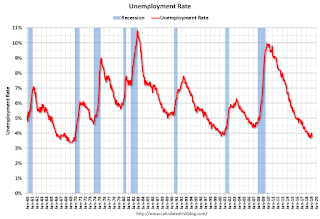 The fourth graph shows the unemployment rate.
The fourth graph shows the unemployment rate. The unemployment rate decreased in February to 3.8%. (Unwinding the bump up from the government shutdown).
This was well below the consensus expectations of 178,000 jobs added, however December and January were up by 12,000 combined. A weak report.
I'll have much more later ...
Thursday, March 07, 2019
Friday: Employment Report, Housing Starts, Speech Fed Chair Powell
by Calculated Risk on 3/07/2019 08:56:00 PM
My February Employment Preview
Goldman: February Payrolls Preview
Friday:
• At 8:30 AM ET, Employment Report for February. The consensus is for 178,000 jobs added, and for the unemployment rate to decline to 3.9%.
• At 8:30 AM, Housing Starts for January. The consensus is for 1.170 million SAAR, up from 1.078 million SAAR.
• At 10:00 PM, Speech by Fed Chair Jerome Powell, Monetary Policy Normalization and Review, At the 2019 Stanford Institute for Economic Policy Research (SIEPR) Economic Summit, Stanford, California
Goldman: February Payrolls Preview
by Calculated Risk on 3/07/2019 04:17:00 PM
A few brief excerpts from a note by Goldman Sachs economist Spencer Hill:
We estimate nonfarm payrolls increased 150k in February ... expect a drag of at least 40k from above-average snowfall during the February survey week.
...
We expect the unemployment rate to move back down a tenth to 3.9% in tomorrow’s report ... the return of furloughed government workers should exert downward pressure on the jobless rate … We estimate that average hourly earnings increased 0.4% month-over-month and 3.4% year-over-year.
emphasis added
February Employment Preview
by Calculated Risk on 3/07/2019 02:11:00 PM
On Friday at 8:30 AM ET, the BLS will release the employment report for February. The consensus is for an increase of 178,000 non-farm payroll jobs in February, and for the unemployment rate to decline to 3.9%.
Last month, the BLS reported 304,000 jobs added in January.
Here is a summary of recent data:
• The ADP employment report showed an increase of 183,000 private sector payroll jobs in February. This was close to consensus expectations of 180,000 private sector payroll jobs added. The ADP report hasn't been very useful in predicting the BLS report for any one month, but in general, this suggests employment growth close to expectations.
• The ISM manufacturing employment index decreased in February to 53.2%. A historical correlation between the ISM manufacturing employment index and the BLS employment report for manufacturing, suggests that private sector BLS manufacturing payroll was unchanged in February. The ADP report indicated manufacturing jobs increased 17,000 in February.
The ISM non-manufacturing employment index decreased in February to 55.2%. A historical correlation between the ISM manufacturing employment index and the BLS employment report for manufacturing, suggests that private sector BLS manufacturing payroll increased 210,000 in February.
Combined, the ISM surveys suggest employment gains slightly above the consensus expectations.
• Initial weekly unemployment claims averaged 226,000 in February, up from 220,000 in January. For the BLS reference week (includes the 12th of the month), initial claims were at 217,000, up from 212,000 during the reference week the previous month.
The increase during the reference week suggests a weaker employment report in February than in January.
• The final February University of Michigan consumer sentiment index increased to 93.8 from the January reading of 91.2. Sentiment is frequently coincident with changes in the labor market, but there are other factors too like gasoline prices and politics.
• Government Shutdown: The unemployment rate should decline in February (government employees on furlough were counted as unemployed in the household survey, but as having a job in the establishment survey).
• Weather could negatively impact the February report.
• Conclusion: In general these reports suggest a solid employment report. There might be some negative impact from weather - and some February hiring might have happened in January (included in the strong report) - so my guess is job growth will be below consensus, but that the unemployment rate will decline to 3.8% or 3.9%.
Fed's Flow of Funds: Household Net Worth decreased in Q4
by Calculated Risk on 3/07/2019 01:11:00 PM
The Federal Reserve released the Q4 2018 Flow of Funds report today: Flow of Funds.
According to the Fed, household net worth decreased in Q4 2018 to $104.3 trillion, from $106.9 trillion in Q3 2018:
The net worth of households and nonprofits fell to $104.3 trillion during the fourth quarter of 2018. The value of directly and indirectly held corporate equities decreased $4.6 trillion and the value of real estate increased $0.3 trillion.The Fed estimated that the value of household real estate increased to $25.9 trillion in Q4. The value of household real estate is now above the bubble peak in early 2006 - but not adjusted for inflation, and this also includes new construction.
 Click on graph for larger image.
Click on graph for larger image.The first graph shows Households and Nonprofit net worth as a percent of GDP. Household net worth, as a percent of GDP, is higher than the peak in 2006 (housing bubble), and above the stock bubble peak.
This includes real estate and financial assets (stocks, bonds, pension reserves, deposits, etc) net of liabilities (mostly mortgages). Note that this does NOT include public debt obligations.
 This graph shows homeowner percent equity since 1952.
This graph shows homeowner percent equity since 1952. Household percent equity (as measured by the Fed) collapsed when house prices fell sharply in 2007 and 2008.
In Q4 2018, household percent equity (of household real estate) was at 60.0% - up from Q3, and the highest since 2002. This was because of an increase in house prices in Q4 (the Fed uses CoreLogic).
Note: about 30.3% of owner occupied households had no mortgage debt as of April 2010. So the approximately 50+ million households with mortgages have far less than 60.0% equity - and about 2.2 million homeowners still have negative equity.
 The third graph shows household real estate assets and mortgage debt as a percent of GDP.
The third graph shows household real estate assets and mortgage debt as a percent of GDP. Mortgage debt increased by $56 billion in Q4.
Mortgage debt has declined by $0.36 trillion from the peak, and, as a percent of GDP is at 49.5%, down from a peak of 73.5% of GDP during the housing bubble.
The value of real estate, as a percent of GDP, was unchanged in Q4, and is above the average of the last 30 years (excluding bubble). However, mortgage debt as a percent of GDP, continues to decline.
Black Knight Mortgage Monitor for January
by Calculated Risk on 3/07/2019 09:52:00 AM
Black Knight released their Mortgage Monitor report for January today. According to Black Knight, 3.75% of mortgages were delinquent in January, down from 4.31% in January 2018. Black Knight also reported that 0.51% of mortgages were in the foreclosure process, down from 0.66% a year ago.
This gives a total of 4.26% delinquent or in foreclosure.
Press Release: Black Knight: Affordability Outlook Improves as Interest Rates Fall; Annual Home Price Growth Continues to Slow, Prices See Fourth Consecutive Monthly Decline
Today, the Data & Analytics division of Black Knight, Inc. released its latest Mortgage Monitor Report, based upon the company’s industry-leading mortgage performance, housing and public records datasets. This month’s report leveraged the latest data from the Black Knight Home Price Index (HPI) to look into the continued slowdown in annual home price appreciation (HPA) and its impact on home affordability. Ben Graboske, president of Black Knight’s Data & Analytics division, explained that while home prices are still up year-over-year in all 50 states and the nation’s 100 largest markets, slowing is noticeable nationwide and – combined with recent interest rate reductions – is helping to improve the overall affordability outlook.
“At the end of December, home prices at the national level had fallen 0.3 percent from November for their fourth consecutive monthly decline,” said Graboske. “As a result, the average home has lost more than $2,400 in value since the summer of 2018. And while home prices are still up on an annual basis, the slowdown continues nationwide and, importantly, is not being driven by seasonal effects. December marked the 10th straight month of slowing annual home price appreciation, falling from a high of 6.8 percent annual growth in February to 4.6 percent at the end of the year. With more than 50 percent of areas reporting, early numbers for January suggest we’re likely to see more of the same. That said, it’s important to keep in mind that annual growth is still outpacing the 25-year average of 3.9 percent – although the gap is closing quickly. Also, it’s yet to be seen what impact the recent pullback in interest rates may have on the national home price growth rate.
“There is good news in these numbers for prospective homebuyers, though. Combined with the average 30-year fixed rate declining by more than half a point over the last three months, housing is now the most affordable it’s been since early in the 2018 home buying season. It currently requires 22.2 percent of median income to purchase the average home with a 20 percent down payment on a 30-year fixed-rate loan. That’s down from a post-recession high of 23.4 percent just a few months ago, and well below the long-term average of 25 percent seen in the late 1990s through the early 2000s, before the housing bubble. The recent decline in rates has translated into a more than 6 percent increase in a homebuyer’s purchase power – while keeping monthly payments the same – or a decrease of $62 a month in principal and interest on the average home bought with 20 percent down. While this is all welcome news for consumers heading into the spring home buying season, it remains to be seen whether recent rate declines and easing affordability will be enough to halt the deceleration in home price growth.”
emphasis added
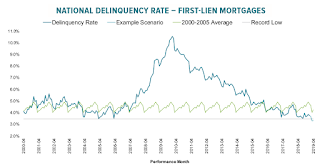 Click on graph for larger image.
Click on graph for larger image.Here is a graph from the Mortgage Monitor that shows the National delinquency rate over time.
From Black Knight:
• At 3.75%, the national delinquency rate now stands nearly a full percentage point below the pre-recession January average of 4.74%The second graph shows the month-over-month and YoY change in the Black Knight House Price Index:
• February and March tend to be two of the strongest performing months, with delinquencies falling by more than 12% over those two months in an average year
...
• If we saw the average seasonal decline this year, the national delinquency rate would fall to 3.3% in March, nearly 20BPS below the previous record low of 3.48% recorded in March of 2005
• A more pessimistic scenario – which may be wise, as March 2019 ends on a Sunday – has delinquencies closer to 3.5% in March (slightly above the record low), but falling to record lows in April
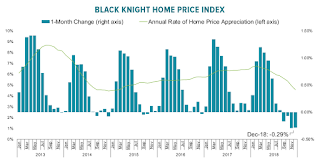
• The average home declined in value by 0.3% (-$850) in December, marking the fourth consecutive monthly decline in home pricesThere is much more in the mortgage monitor.
• December marked the 10th straight month of slowing annual home price appreciation (HPA), falling from a high of 6.8% annual growth in February to 4.6% at the end of the year
• With more than 50% of areas reporting, early numbers for January suggest we’re likely to see more of the same
…
• Also, it’s yet to be seen what impact the recent pullback in interest rates may have on the national home price growth rate as late December/early January declines haven’t had time to manifest themselves in terms of closed home sales


